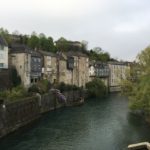 Oloron Sainte Marie to Tarbes – 68km (N134 & D936)
Oloron Sainte Marie to Tarbes – 68km (N134 & D936)
Tarbes to Saint Gaudens – 67km (D817, D938, D638, D817)

The elevation charts reflect the fact that we have been cycling across the foothills of the Pyrenees, rather than away from them. In retrospect, this was not the most sensible routing decision, but it avoided the large city of Toulouse and is the most direct route to Montpellier, where we soon get to have another visit with our new grandson and his big sister!
Oloron-Sainte-Marie is in the Aquitaine region of south-west France. The earliest inhabitants in the south-west were thought to be the Aquitani, who were not proper Celtic people, but more akin to the Iberians. It is believed that the prevailing language of Aquitaine during the late pre-historic to Roman period was an early form of the Basque language. Oloron is also famous as the capital of the basque beret.
We left Oloron in a low mist, which obscured views of the snow-capped Pyrenees and made cycling along the busy, shoulderless N134 a bit difficult. We turned off on the much quieter D936, which took us up through Rébénacq, where we stopped for coffee, and Nay, for lunch. We noticed the Musée du Béret in Nay, which sells the traditional Basque berets made in Oloron. The last 20 kms before Tarbes was flat, but once again very busy and without a shoulder. We saw signs to Lourdes, another major Catholic pilgrimage site, and passed the Aéroport de Tarbes-Lourdes-Pyrénées, where many large passenger jets were lined up to be dismantled.

Tarbes is a large industrial town. Our hotel was new, but next to several revitalized buildings. We discovered that these were formerly an armaments factory from 1871 to 2006. Of interest is that Jean Baptiste Vechère de Reffye moved an experimental artillery workshop here from Meudon (where Chris and Shinyoung now live) to commence the production.
The region has a history of textile production which accounted for seeing many old mills. Sheep supplied wool and supply milk for very fine cheese, some of which we have been eating for lunch on the road.
Today’s ride took us through rolling countryside with the mountains to the south, covered in clouds. Lilac and wisteria were in full bloom. We passed through many villages and small towns such as Tournay, where we had coffee. This was, to us, a typical community of the area, with a busy square, plane trees, a dominant Marie and narrow streets. The small villages seemed to be dominated by agriculture. The rain, which had been forecast, held off, but it was a grey, cold day.
We are looking forward to connecting with family tomorrow, Easter Sunday, as we take a break in Saint Gaudens.
Coffee note: no espresso with a score greater than 5.5/10, as yet in France. We’re missing Portuguese espresso!








